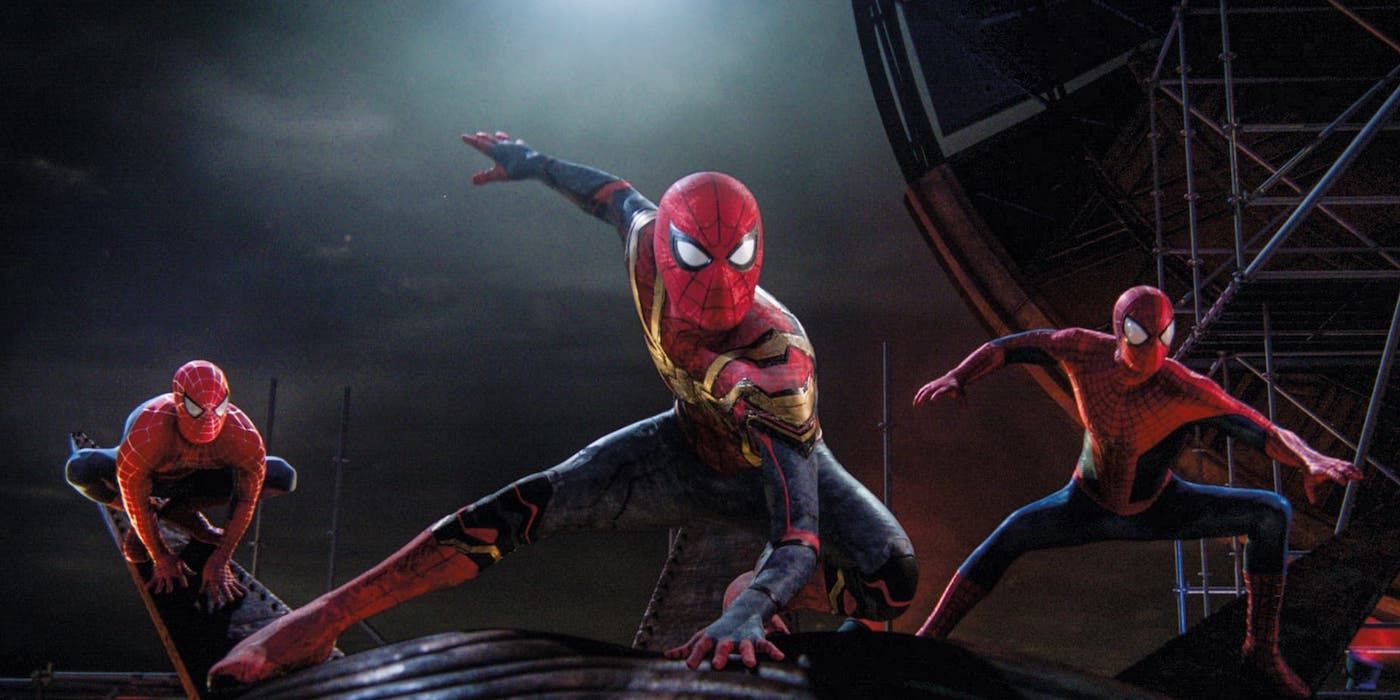Spider-Man’s Greatest Villain Is…Sony
The Big Picture
- Sony Pictures’ involvement in the Spider-Man franchise has been more villainous than any of the on-screen adversaries.
- Sony’s control over Spider-Man led to a reboot of the franchise and ambitious plans for a Spider-Man Universe without Spider-Man.
- Despite the partnership with Marvel Studios, Sony’s actions have diminished Spider-Man’s value and made him irrelevant to a universe which bears his name.
Of all the villains that Spider-Man has faced in the movies, there is one that has posed, and continues to pose, the greatest threat he has ever faced. Green Goblin, so deliciously brought to life by Willem Dafoe? Alfred Molina‘s Dr. Octopus, who has featured in Rotten Tomatoes’ top two live-action Spider-Man films? Electro, Jamie Foxx‘s contribution to The Amazing Spider-Man 2? Surely it’s Mysterio, played by Jake Gyllenhaal, whose public outing of Tom Holland‘s Spider-Man caused massive repercussions that still resonate in the MCU? Nope. Here’s a hint — think behind the camera. That’s right, the greatest villain that Spider-Man has ever known is Sony Pictures, and like all great comic-book villains, they can’t be stopped.
Sam Raimi Starts Out Hot With ‘Spider-Man’ & ‘Spider-Man 2’
With the wealth of superhero films today, it may be surprising to know that the genre was, for all intents and purposes, dying in the late 1990s. Christopher Reeve‘s Superman went out with a whimper, with 1987’s Superman IV: The Quest for Peace being the box-office kryptonite that ended the iconic hero’s presence on screen for years. The Batman film franchise that began with Tim Burton‘s defining 1989 Batman was slain by George Clooney in 1997’s Batman & Robin. But at least the heroes of DC Comics had a taste of big-screen success. Marvel had yet to find any, with no Marvel heroes headlining their own films, and those that did were dodgy at best, if not outright horrible (we’re looking at you, Howard the Duck).
Complicating matters for Marvel was the well-publicized fact that the movie rights to their characters had become convoluted, with different studios owning the rights to select characters, like Universal Pictures owning Namor the Sub-Mariner and The Hulk (interestingly, Sony could have landed all the characters that were still under Marvel, Iron Man, Thor, etc., for a cool $25 million — talk about hindsight). 1998’s Blade gave Marvel its first mainstream success story, a glimmer of hope that Marvel Comics could be translated on screen effectively. Early suitors for Spider-Man included MGM and 20th Century Fox, with none other than James Cameron ready to put his unique take on the character with the studio. Both ended up passing, which opened the door for Sony to pursue the film rights to Marvel’s number one protagonist.
Eventually, Sony Pictures CEO John Calley landed a pretty sweet deal for the rights: $7 million, with Marvel retaining 5% of the profits and 50% of the merchandising (if only Calley had the foresight to drop another $18 million to land them all). With rights in hand, work began on landing a director for the project, with Sam Raimi winning out after impressing the executives with his long-time passion for Spider-Man. With Tobey Maguire cast as Peter Parker/Spider-Man, and Kirsten Dunst on board as Mary Jane, filming commenced, and the rest, as they say, is history. Spider-Man took in $825 million, a critical and box-office hit, while the 2004 follow-up Spider-Man 2 grossed $788 million, scoring even better with critics than the first and still lauded as one of the best in the superhero genre.
Sony Reboots Spider-Man With ‘The Amazing Spider-Man’ Films
Things began taking a turn for the worse when the time came for Spider-Man 3. Raimi had delivered the most successful superhero films to date, and clearly had an intrinsic knowledge of what made Spider-Man work on film. The easy odds would have been to let Raimi continue weaving his web and reap the benefits, but as we’ve learned over time, villains can’t just leave things alone. Such was the case with Sony. Producer Avi Arad pushed Raimi to include Venom in the film (Arad confesses it was his idea in an interview with Screen Rant), a move spurred on by the popularity of the character with young comic book fans. Raimi wasn’t familiar with the character, nor did he like the character, and as a result he had trouble putting his all into the film, and it showed. But it made money, the highest-grossing of the original trilogy, so any lessons that should have been learned by Sony fell on deaf ears. As a result, Raimi walked away from Spider-Man 4 after Sony started pushing for the Lizard to be in the film — a film they also wanted in 3D, which was a stipulation they mandated halfway through pre-production.
Now without Raimi in the way, Sony had full control of Spider-Man, bringing on Marc Webb to direct, with actor Andrew Garfield taking over from Maguire, which led to The Amazing Spider-Man. It didn’t pick up where Raimi left off, but instead rebooted the entire franchise from scratch, with Spider-Man’s origin story being played out again, only 10 years removed from Raimi’s first film (an issue similar to the Batman films). It, too, made money, but with highly mixed reviews. To hell with the reviews, though. Now Sony had even bigger ambitions for their Spider-Man Universe, with the full intention of using The Amazing Spider-Man 2 as a launching pad for expanding the franchise, specifically a Sinister Six spin-off that would feature six of Spider-Man’s villains. Only The Amazing Spider-Man 2 drew worse reviews, and box office intake, than the first. Their devious Spider-Man plans had, thankfully, been stopped. But when has a villain ever given up?
Marvel and Sony Collaborate on Tom Holland’s ‘Spider-Man’ Films
Meanwhile the MCU had been born, a veritable juggernaut that was changing the game in regard to the superhero genre. With their hopes of cinematic domination effectively dead, Sony worked out a deal that would allow Marvel Studios to use Spider-Man in the MCU, beginning with his appearance in Captain America: Civil War. The response was overwhelmingly positive, with Tom Holland an absolute winner in the role. The MCU had reinvigorated interest in the wall-crawler, reviving Sony’s nefarious Spider-Man Universe plans. Holland’s Spider-Man was the headliner in two MCU films — Spider-Man: Homecoming and Spider-Man: Far From Home — and an integral part of both Avengers: Infinity War and Avengers: Endgame. All seemed well… and then Sony struck.
Sony now had leverage, and in 2019, news of an acrimonious standoff between Disney and Sony resulted in the involvement of Kevin Feige and Marvel Studios with Spider-Man ending. A Sony spokesperson then added, “we are grateful for his [Feige’s] help and guidance and appreciate the path he has helped put us on, which we will continue.” In other words, “Thanks for fixing our toy. We’re just going to take him back now.” The news did not sit well with fans, who had come to accept that Spider-Man would just continue to be in the MCU. But it was a win for Sony, who simply could carry on with the same Spider-Man, only now in Sony’s Spider-Man Universe, which had just started to expand with the 2018 release of Venom.
However, the bad publicity pushed the warring factions back to the table, with a new deal that kept Holland’s Spider-Man in the MCU. It also opened the door for characters from the Sony Spider-Man Universe to appear in the MCU, with the appearance of both Maguire and Garfield’s Spider-Man in Spider-Man: No Way Home with Holland, and Tom Hardy‘s Venom teased in the mid-credits scene of the film. Again, though, by having loaned Marvel their Spider-Men, it served an underhanded purpose for Sony by legitimizing and renewing interest in their heroes.
Sony Has a Spider-Man Universe Without Spider-Man
Sony definitely made decisions along the way with Spider-Man that hinged on dastardly, but their true evil intentions with Spider-Man are that they don’t include Spider-Man at all. As alluded to earlier, 2018’s Venom was ground-zero for the SSU, followed up by Venom: Let There Be Carnage. Those films would prove that Avi Arad’s belief in the character wasn’t completely out to lunch, and his popularity apart from Spider-Man meant that a stand-alone film with the antihero worked. Likewise, the animation arm of Sony hit a home run with both Spider-Man: Into the Spider-Verse and Spider-Man: Across the Spider-Verse, with a Spider-Man in the lead; not the Spider-Man of the live-action films, but with Miles Morales (Shameik Moore) instead. But starting with the debacle that is 2022’s Morbius, Sony began moving forward with their plan for a Spider-Man Universe… without Spider-Man.
Morbius was never remotely close to being as popular as Spider-Man or Venom. But it gets worse. 2024 will see the release of Kraven the Hunter. Who’s he? That’s the problem. Kraven is one of Spider-Man’s enemies from the comics, but not a particularly well known one. He is, however, more well known than the protagonist of Madame Web, a clairvoyant and precognitive mutant that first appeared in Marvel Comics in 1980. Ask anyone on the street who Kraven is, and you might get an answer, but ask about Madame Web and the most likely scenario is a vacant stare. These characters do not exist without Spider-Man, nor do Nightwatch, Jackpot, or El Muerto, all Marvel characters with SSU films in various stages of development. And it’s this that makes Sony Spider-Man’s greatest villain. With each SSU release, Spider-Man’s value as an integral part of the narrative is diminished, especially as the characters are developed for film having dropped any connection to the hero. In doing so, Sony does what villains throughout history have failed at: defeating Spider-Man, by making him irrelevant to a film universe that bears his name.
The Spider-Man films are available to stream on Disney+ in the U.S.
Watch on Disney+
#SpiderMans #Greatest #Villain #IsSony


